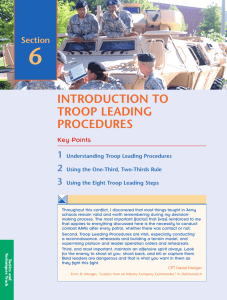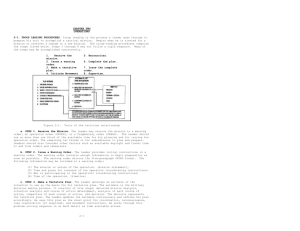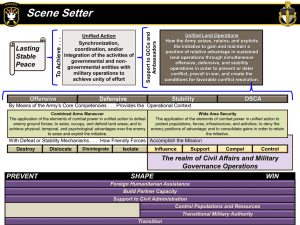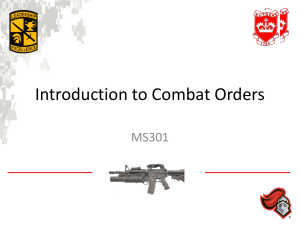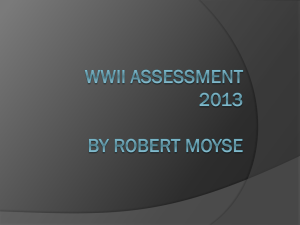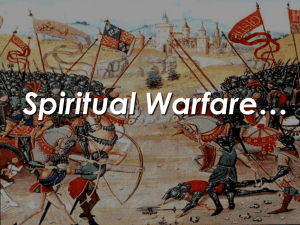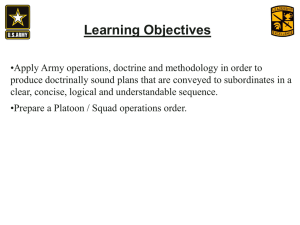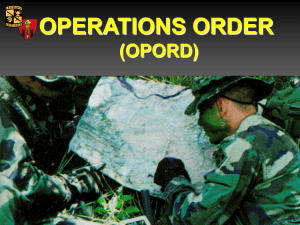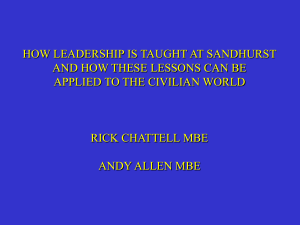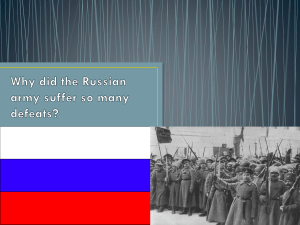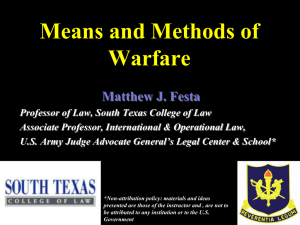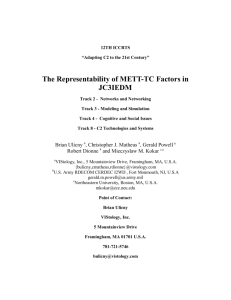Introduction to Combat Orders - Rutgers University Army ROTC
advertisement
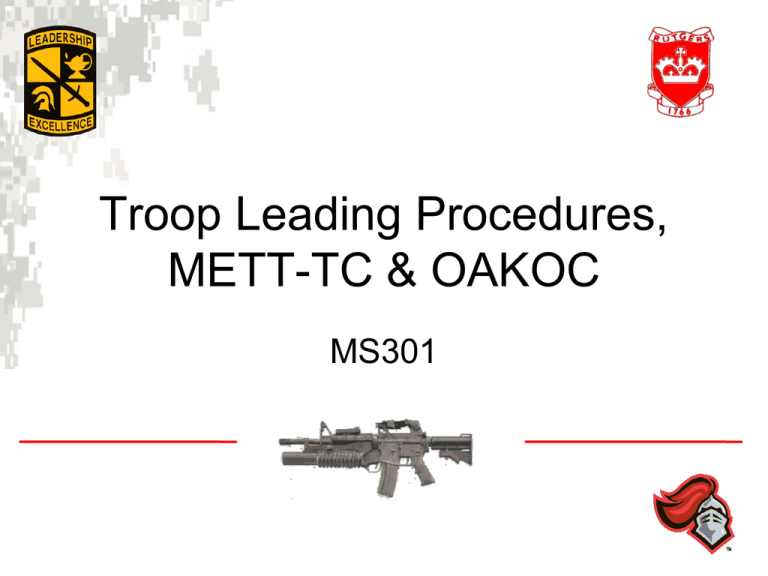
Troop Leading Procedures, METT-TC & OAKOC MS301 References • • • • • FM 3-21.8 FM 7-8 Infantry Platoon and Squad SH 21-76 Ranger Handbook FM 1-02 Operational Terms and Symbols FM 5-0 Army Planning and Orders Production AGENDA Troop Leading Procedures: 1. RECEIVE THE MISSION 2. ISSUE A WARNING ORDER 3. MAKE A TENTATIVE PLAN 1. METT-TC I. OAKOC 4. INITIATE MOVEMENT 5. CONDUCT RECONNAISSANCE 6. COMPLETE THE PLAN 7. ISSUE THE OPERATIONS ORDER 8. SUPERVISE AND REFINE TROOP LEADING PROCEDURES (TLP) • Troop Leading Procedures is a sequence of actions that help leaders use available time effectively and efficiently to issue orders and execute tactical operations • The TLP begin with the first indication of an upcoming mission or a change to an existing mission. • The troop-leading procedures comprise of 8 steps The first three steps must be done in sequence, with Steps 3 through 8 may not follow a rigid sequence. Many of the steps may be accomplished concurrently. TROOP LEADING PROCEDURES 1.RECEIVE THE MISSION 2.ISSUE A WARNING ORDER 3.MAKE A TENTATIVE PLAN 4.INITIATE MOVEMENT 5.CONDUCT RECONNAISSANCE 6.COMPLETE THE PLAN 7.ISSUE THE OPERATIONS ORDER 8.SUPERVISE AND REFINE STEP 1. RECEIVE THE MISSION •The leader may receive the mission in a Warning Order (WARNO), an operation order (OPORD), or a fragmentary order (FRAGO). •The leader analyzes the mission using METT-TC, at a minimum from a friendly and especially from the enemy’s perspective in order to craft logical Courses of Action (COAs) • The leader should use no more than 1/3rd of the available time for his own planning and for issuing his OPORD. • The remaining 2/3rds is for subordinates to plan and prepare for the operation. • Leaders should also consider other factors such as available daylight and travel time to and from orders and rehearsals. STEP 2. ISSUE A WARNING ORDER • The leader provides initial instructions in a Warning Order. The WARNO contains enough information to begin preparation as soon as possible. • The warning order mirrors the five-paragraph OPORD format. • The following information may be included in a warning order. • Information about the enemy situation (enemy SITEMP) •The mission or nature of the operation. (mission statement) • Time and place for issuance of the operation (coordinating instructions) • Who is participating in the operation? (coordinating instructions) • Time of the operation. (timeline) • Issuance of a solid WARNO to subordinate units will increase mission capability through the effective use of available time to rehearse and develop COAs **IF NOTHING ELSE, ENSURE YOU CAN GET THE MISSION STATED, AND A BRIEF TIMELINE. EVEY SOLDIER MUST KNOW WHAT THEIR DOING, AND WHEN THEIR DOING IT** UNIT DES: 1. WARNING ORDER 4. SUSTAINMENT SITUATION a. General b. Enemy c. Friendly 2. MISSION 5. COMMAND AND CONTROL 3. EXECUTION a. c. Mission Rehearsals b. MVMT Instructions c. RECON Instructions d. OPORD Prep Time: Place: PAX: DTG: DTG / EVENT / PER TIMELINE SQD/PLT OPORD: RXL’s: PCI/PCC: LD: ORP: SBF SET: HIT TIME: LOA: STEP 3. MAKE A TENTATIVE PLAN • The leader develops an estimate of the situation to use as the basis for his tentative plan •Crafting a tentative plan can be broken down in to six steps: •Receipt of the mission •Mission Analysis –METT-TC, OAKOC and Light / Weather Impacts •COA Development •COA Analysis •COA Selection •Issue the order •Mission analysis is critical to the success of the mission in its planning and execution phases. •The use of METT-TC in the analysis of any mission will allow the leader to develop significant conclusions about each element and its impact on mission accomplishment METT-TC M- MISSION E- Enemy T- Terrain T-Troops T-Time C- Civilian Considerations METT-TC M- Mission- The leader must have a clear understanding of the mission, intent and concept. It does not have to be done in a specific order •The leader must understand the following elements in order to effectively analyze the mission: •Battalion Mission, Intent and Concept- Understand the higher unit’s mission, tasks and the leader’s place within it •Company Mission, Intent and Concept- Understand the higher unit’s mission, tasks and the leader’s place within it •Platoon Mission- Understand the tasks and place which the leader’s mission supports the main effort unit •Constraints- restrictions placed on the leader from higher •Identification of tasks, Specified, Implied and Essential•Specified- Tasks explicitly assigned in Paragraphs 2 & 3 of the order •Implied- Tasks the leader indentifies that must be performed in order to accomplish the mission, but are not stated in the OPORD •Essential- Tasks that must be accomplished in order to accomplish the Mission •Identification of Risks- The chance of death or injury in relation to the mission •Restated Platoon Mission Statement- 5 W’s Who, What, When, Where, Why with a sound Task and Purpose METT-TC E- Enemy- The leader indentifies the potential strengths and weaknesses of the enemy •When analyzing the enemy the leader must consider the following areas in order to conduct a thorough analysis of the enemy •Composition- number and types of enemy weapons and equipment that could be used against the leader’s unit •Disposition- the surmised array of the enemy’s capabilities against the leader’s unit •Strength- the leader determines the approximate of equipment and personnel that the leader’s unit is expected to fight or that may effect his unit •Capabilities- the assessment of the enemy’s doctrine and current location. The leader determines what the enemy is capable of doing with its equipment and weapons, i.e. weapons ranges for each enemy weapon system •Anticipated Enemy Courses of Action- Identify potential enemy COAs and develops a SITEMP, a graphic overlay to brief off of •Most Probable Course of Action (MPCOA)- The most probable course of action that the leader develops for the enemy based on the analysis conducted i.e. Composition, Disposition etc. •Most Dangerous Course of Action (MDCOA)The most dangerous course of action the enemy is expected to Take by the leader after analyzing its Composition, Disposition METT-TC T- Terrain (& Weather)- the leader conducts a detailed analysis of the terrain to determine how it will uniquely affect the unit and the enemy that it is fighting. •Terrain mobility- is classified into three categories: •Unrestricted- this is terrain that is free of any movement restrictions. It is terrain that allows wide maneuver and offers unlimited travel over well developed road networks •Restricted- terrain that hinders movement to some degree, and units may need to detour frequently. Encompasses steep slopes, moderate to dense spacing of obstacles such as trees, rocks, or buildings. Movement in restricted terrain may provide a unit more cover and concealment. •Severely Restricted- terrain that severely hinders or slows movement in combat formations unless some effort is made to enhance mobility. It may require the commitment of engineers to improve mobility or a deviation from doctrinal tactics to maintain speed of movement METT-TC OAKOC T- Terrain (& Weather)- the leader conducts a detailed analysis of the terrain to determine how it will uniquely affect friendly and enemy forces alike. •Military aspects of terrain- the military aspects of terrain is an important aspect of planning that all leaders must understand. Analysis of terrain can be accomplished by the use of OAKOC. O- Observation and Fields of Fire A-Avenues of Approach K-Key and Decisive Terrain O- Obstacles C-Cover and Concealment METT-TC OAKOC O- Observation and Fields of Fire- The leader analyzes the way in which the terrain will impact the ability to both the enemy’s and friendly unit’s ability to observe troop movement and the ability to engage them with its assigned weapon systems •Observation can by hindered by intervisibility lines (IV), terrain that inhibits observation from one point to another e.g. dead space / thick woods / opposing side of a slope or depression •Fields of Fire determine the ability of both friendly forces to utilize their direct fire capabilities and positions that enable artillery observers to call for indirect fires and permit snipers to engage targets METT-TC OAKOC A- Avenues of Approach- an avenue of approach is an air or ground route of an attacking force leading to its objective or key terrain. •Avenues of Approach can be determined by the type (Mounted or Dismounted etc.) size, and formation and speed of the largest unit that can travel along it. •A dismounted force can consider restricted and severely restricted terrain as viable avenues of approach, while mounted forces can move along unrestricted and restricted terrain •Understanding the most likely avenue of approach an enemy unit can take will allow the leader to emplace appropriate weapons systems to counter the threat or develop contingencies METT-TC OAKOC K- Key Terrain- affords a marked advantage to the combatant who seizes, retains or controls it. The leader assess key terrain from the objective backwards to his current position. • Examples of key terrain: • the control of a tree line on a hillside that provides overwatch of a high speed avenue of approach • High ground alone is not key terrain, however high ground that overlooks an avenue of approach and offers clear observation and fields of fire and cannot be bypassed is. •Key terrain can be evaluated by using Observations and Fields of Fire and Cover and Concealment to determine its value. METT-TC OAKOC O- Obstacles- Obstacles are determined by the leader to be existing or reinforcing •Existing Obstacles- typically natural terrain features present on the battlefield e.g. ravines, ditches over 3-meters wide, tree stumps and large rocks etc. •Reinforcing Obstacles- typically manmade obstacles that augment existing obstacles. They include minefields, AT ditches, road craters, abatis, wire obstacles and infantry strong points. METT-TC OAKOC C- Cover and ConcealmentCover- is protection from the effects of fires Concealment- is protection from observation, but not direct or indirect fires •the leader analyzes the terrain and determines terrain that best provides enough cover to mitigate the effects of fires and concealment to mask the units movement or position from enemy observation METT-TC OAKOC Weather- weather like terrain can affect the leader’s ability to accomplish the mission. The affects of weather, like terrain, must be analyzed by the manner in which it impacts friendly and enemy units alike. The five military aspects of weather: VisibilityWinds Precipitation Cloud cover Temperature/humidity METT-TC T-Troops- Analysis of your composition, disposition, capabilities of your force and the demands of the mission on your element. T-Time- Analyze the time constraints in which your mission must take place and its possible effects on your mission. C-Civilian Considerations- Analyze the impact of civilians on your mission, positive or negative. i.e. are you passing by a holy site on your patrol. Light and Weather Five Military aspects of weather 1. Visibility 2. Winds 3. Precipitation 4. Cloud Cover 5. Temperature/ Humidity Light and Weather • As a leader you must take into account the ways in which weather will affect your mission. It is not enough to make cursory observations of the weather, you must go deeper and identify the critical conclusions. • Once you have identified and made your critical conclusions you must apply them to both the enemy and friendly COAs. Critical Conclusions: 1. Visibility• How will fog, smog, haze , humidity and battle field obscurants (e.g. deployed smoke) affect the mission? • Does the current weather favor use of smoke to obscure a breach site? • How will fog affect friendly and enemy target acquisition? Light and Weather 2. Winds• What is the wind speed and direction? • Will the wind speed cause smoke to dissipate quickly? • Does the wind direction and speed favor enemy use of smoke? 3. Precipitation• What are the effects of precipitation, type duration and amount on the mission? • How will precipitation affect mobility? • How can precipitation add to the platoon achieving surprise? 4. Cloud Cover• How does cloud cover or lack thereof impact target acquisition, aircraft approach and radar effectiveness? • Will heavy cloud cover limit illumination and solar heating of targets? • Will heavy cloud cover degrade the use of infrared-guided artillery? Light and Weather 5. Temperature / Humidity• How will the temperature hot or cold, affect the mission? • How will the temperature hot or cold affect the rate of a foot march? • How will the temperature affect Soldiers and equipment? Light Data• When is BMNT, EENT, SR, SS, MR, MS and the percentage of illumination? • Will the sun rise behind my attack? • How can I take advantage of the limited illumination? • How will limited illumination affect friendly and enemy target acquisition? STEP 4. INITIATE MOVEMENT • The leader initiates any movement that is necessary to continue preparations or to posture the unit for the operation •Movement to the Assembly Area (AA), battle position, perimeter defense, or attack position • Drawing of ammunition or filling of other logistical requirements that is necessary to the mission and can be accomplished, benefiting the units readiness to conduct the mission before the issuance of the final order STEP 5. CONDUCT RECONNAISSANCE • The leader must conduct a reconnaissance in order to develop the plan. The focus of the reconnaissance is to confirm the priority intelligence requirements that support the tentative plan •The leader can include subordinate leaders in the reconnaissance, or may conduct a subordinate unit conduct the reconnaissance with specific objectives. •The leader can conduct a reconnaissance through other means to include: • Satellite imagery • Maps • Patrols from other units • Video from unmanned aerial vehicles (UAVs) • At a minimum you must conduct a Map Reconniassance! STEP 6. COMPLETE THE PLAN • Completion of the plan entails the transformation of the commander’s intent and concept and the platoon concept into a fully developed platoon OPORD. • This includes the preparation of overlays, coordinating Indirect fire lists, completing sustainment and command and control requirements, and updating the tentative plan after the conducting of reconnaissance • Final coordination with other units and or the commander before issuing the OPORD STEP 7. ISSUE THE OPERATIONS ORDER • The 5 paragraph OPORD precisely and concisely explains the mission, the commander’s intent and concept of the operation •The platoon leader issues the OPORD in person, looking into the eyes of all his soldiers to ensure each leader and soldier understands the mission • The platoon leader uses visual aides, such as sandtables and concept sketches to depict movement and actions on the objective STEP 8. SUPERVISE AND REFINE • Supervising the actions of subordinates during the conduct of mission preparation is crucial to the success of the unit towards mission accomplishment. • The leader conducts confirmation briefs, inspections and rehearsals. •The leader can utilize pre-combat checklists in order to stay on track and not overlook any detail in the preparation for the mission •Confirmation briefings i.e. back briefs, are essential to ensure that the oral order has been understood by subordinate leaders • The conduct of quality rehearsals, efficiently run and executed will allow subordinate leaders to reinforce unit SOPs and increase the proficiency of executing critical tasks •Rehearsal techniques include: •Map Rehearsal • Sand Table or Terrain Model • Radio Rehearsal • Reduced-Force Rehearsal • Full-Force Rehearsal Questions? Move out and draw fire!
